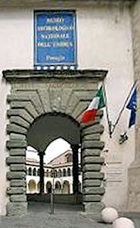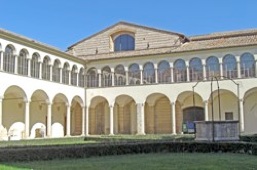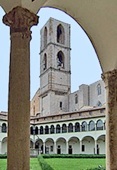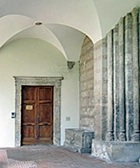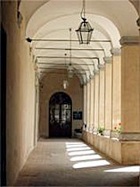This imposing portal to the left of the church leads to the large cloister of the ex-convent of San Domenico.
The Dominicans built this convent in 1234, when the podestà Ramberto de Gisleriis granted them two plots of land next to the parish church of Santo Stefano del Castellare. It had a school of theology by 1260 and a fine library.
The complex was suppressed in 1860 and put to military use. The Dominicans were able to return to part of their old convent in 1956. However, the larger part of it now houses the Museo Archeologico Nazionale dell' Umbria.
Large Cloister (1455-1589)
The large cloister was built on two storeys, the upper one of which is now enclosed. The well [date] at the centre that came from the Palazzo dei Priori.
The lower loggia, the arches of which are open, contains 40 travertine columns:
-
✴the facade of the ex-church of San Domenico Vecccio can be seen diagonally opposite the entrance; and
-
✴the left wall of the adjacent church of San Domenico and its campanile are on the right.
The door at right angles to the facade of San Domenico Vecchio leads to rooms that originally housed the
Oratorio di San Domenico.
Small Cloister
Walking clockwise from this point, just beyond the facade of the ex-church, you come to the entrance to the original cloister of the convent, which a loggia on three sides and abuts a conventual building on its fourth side. You can only see the lower part of the loggia from here, but it is in fact built on two storeys. (The upper storey forms part of the Museo Archeologico). The corridor along the south side of this cloister leads to the ex-library (1475-81), which now houses the State Archives.
Art from the Large Cloister
Scenes from the life of St Dominic (1579-81)
According to local historians, Giovanni Battista Lombardelli painted these frescoes in the large cloister at the expense of families who had burial rights in the church. They were already described as ruined in 1857, largely due to damage inflicted by French soldiers in 1797.


